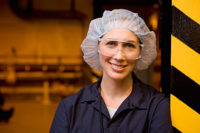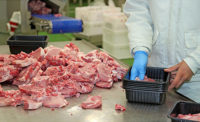Food Safety
Convenience aids employee hygiene

Several common methods for maintaining employee cleanliness exist. First, the areas directly in and around where employees enter the production environment must be kept clean. Clear expectations and procedures around handwashing must be set, and a good personal protective equipment (PPE) program must be in place. Lastly, it is crucial that processors have easily accessible and common locations for handwashing and as well as donning and doffing PPE.
“There will always be pitfalls to employee hygiene because everyone has a different interpretation of clean,” says Lee Johnson, vice president of technical services for West Liberty Foods, West Liberty, Iowa. “It is important for each company to train and set a basic level of expectations needed in high-care areas. From my standpoint there are no new major challenges. It is a continuous and evolving process of training and education.”
Placement of sanitation systems is key with the overarching theme of both handwashing and boot washing to make it easy for the employee to do the activity. “If it’s easy for them, compliance is better,” Johnson explains. “Convenient access from the worksite to sinks and handwashing stations is proven to be successful.”
An example of advancement in employee hygiene technology is fully automated hand-washing and boot washing stations.
“You must ensure that the sanitation process is convenient, frequent and quick to use,” Johnson explains. “I would much rather see someone washing their hands multiple times as a precaution over the duration of their shift because the sanitation system is more readily available over the employee who doesn’t feel like going out of their way to find the handwashing station.”
Processors also are tracking and making sure employees are following the rules of employee hygiene.
“A quick and easy way to make sure hygiene compliance is being met is to color code PPE so the room can easily be scanned to make sure people are in the correct areas to minimize risk,” Johnson says. “You can also install video cameras in production areas and have pre-shift group safety talks to emphasize the importance of hygiene.”
Last but not least, training and handwashing exercises prior to entering the production floor are essential for employees, Johnson adds.
For many years, West Liberty Foods has used encapsulated suits that cover the employee from head to toe, ensuring all contaminants stay out of the production environment. “We also conduct thorough training on sanitation and have complete separation between raw and ready-to-eat areas,” Johnson says. “We designate this with different colored boots and frocks. Lastly, we have multiple boot washes located throughout each of our facilities.”
Ultimately, if processors want to keep the contaminants out, they must provide the right equipment for their production environment. “While you can’t control personal hygiene outside of the business environment you can and must control what happens in your manufacturing environment,” Johnson says. NP
Looking for a reprint of this article?
From high-res PDFs to custom plaques, order your copy today!








